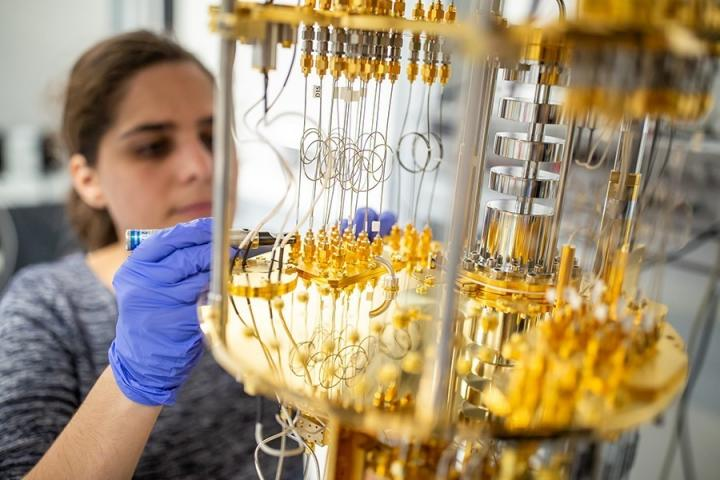Jun 25 2020
Advanced quantum networking, by two U.S. Army research projects, is expected to play a major role in upcoming battlefield operations.
 Two U.S. Army research projects at the University of Chicago advance quantum networking, which will play a key role in future battlefield operations. Image Credit: University of Chicago, Nancy Wong.
Two U.S. Army research projects at the University of Chicago advance quantum networking, which will play a key role in future battlefield operations. Image Credit: University of Chicago, Nancy Wong.
It is believed that quantum networks can deliver many innovative capabilities that otherwise cannot be achieved with traditional networks; one of the capabilities is secure quantum communication.
Data in quantum communication protocols is usually sent across entangled photon particles. Eavesdropping on quantum communication is an almost impossible task, and individuals who do so tend to leave proof of their tampering.
But conveying quantum data through photons across conventional channels, like fiber-optic lines, is not easy—most often, the photons carrying the data are either lost or corrupted, rendering the signals incoherent or weak.
In the first research, the scientists from the University of Chicago, financially supported and controlled by the U.S. Army’s Combat Capability Development’s Army Research Laboratory’s Center for Distributed Quantum Information, described a novel quantum communication method that effectively bypasses those conventional channels.
The researchers connected a pair of communication nodes with a channel and transmitted data quantum-mechanically between the communication nodes—making sure that the linking channel was never occupied.
This result is particularly exciting not only because of the high transfer efficiency the team achieved, but also because the system they developed will enable further exploration of quantum protocols in the presence of variable signal loss. Overcoming loss is a key obstacle in realizing robust quantum communication and quantum networks.
Dr Sara Gamble, Program Manager, Army Research Office, U.S. Army Research Laboratory
Dr Gamble is also a co-manager of the Center for Distributed Quantum Information.
Published in the Physical Review Letters journal, the study created a system that linked a pair of communication nodes by making use of microwave photons—the same kinds of photons employed in cell phones—via a microwave cable.
For this kind of experiment, the researchers employed a microwave cable measuring around 1 m in length. When they turned the system on and off in a regulated way, they not only quantum-entangled the two nodes but also transmitted the data between them but without ever having to transmit the photons via the cable.
We transferred information over a one-meter cable without sending any photons to do this, a pretty unusual achievement. In principle, this would also work over a much longer distance. It would be much faster and more efficient than systems that send photons through fiber-optic channels.
Dr Andrew Cleland, the John A. MacLean Sr. Professor of Molecular Engineering, Pritzker Molecular Engineering, University of Chicago
Dr Cleland is also a senior scientist at Argonne National Laboratory.
The system has certain restrictions—it should be kept extremely cold, that is, at temperatures slightly above absolute zero. But according to the scientists, the system may also function at room temperature with atoms rather than photons.
The researchers are currently performing experiments that would allow them to entangle a number of photons collectively in a more complex state, which may eventually allow for improved quantum communication capabilities and protocols.
However, entangled particles are not simply restricted to atoms or photons. In a second study published in Physical Review X—a peer-reviewed journal—on June 12th, 2020, the same research team from the University of Chicago entangled a pair of phonons—that is, the quantum particle of sound. This was a new breakthrough.
The researchers used a system developed to interact with phonons, analogous to the photon quantum communication system, and linked a pair of microwave phonons. These microwave phonons have a pitch that is about a million times higher than can be heard with the human ear.
After entangling the phonons, the researchers employed one of the two phonons as a herald, which was used to observe how the other phonon was used by the researchers’ quantum system. This herald enabled the researchers to carry out a supposed quantum eraser experiment, where data is removed from a measurement, even after the completion of the measurement.
Phonons give you a much bigger time window to do things and relieve some of the challenges in doing a quantum eraser experiment.
Dr Andrew Cleland, the John A. MacLean Sr. Professor of Molecular Engineering, Pritzker Molecular Engineering, University of Chicago
While phonons have plenty of drawbacks over photons—for instance, they are likely to be shorter-lived—they communicate powerfully with several solid-state quantum systems that may not do so with photons. Consequently, phonons can potentially offer a more improved method to bind to these systems.
Such binding is a major capability for several quantum networking applications, and may even prove useful for other quantum information science applications, like quantum computing. Moreover, phonons have shorter wavelengths when compared to those of photons for the same frequency, possibly allowing smaller quantum circuits.
“Together, these experiments provide multiple avenues for future research into how we construct quantum networks that function in non-ideal environments, and reliably transfer quantum information between systems,” stated Dr Fredrik Fatemi, researcher at the laboratory and co-manager of the Center for Distributed Quantum Information. “Both are critically important for developing future quantum technologies.”
Journal Reference:
Chang, H.-S., et al. (2020) Remote Entanglement via Adiabatic Passage Using a Tunably Dissipative Quantum Communication System. Physical Review Letters. doi.org/10.1103/PhysRevLett.124.240502.